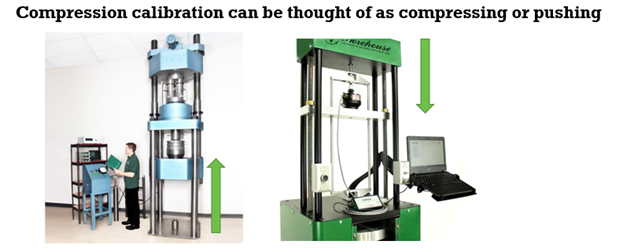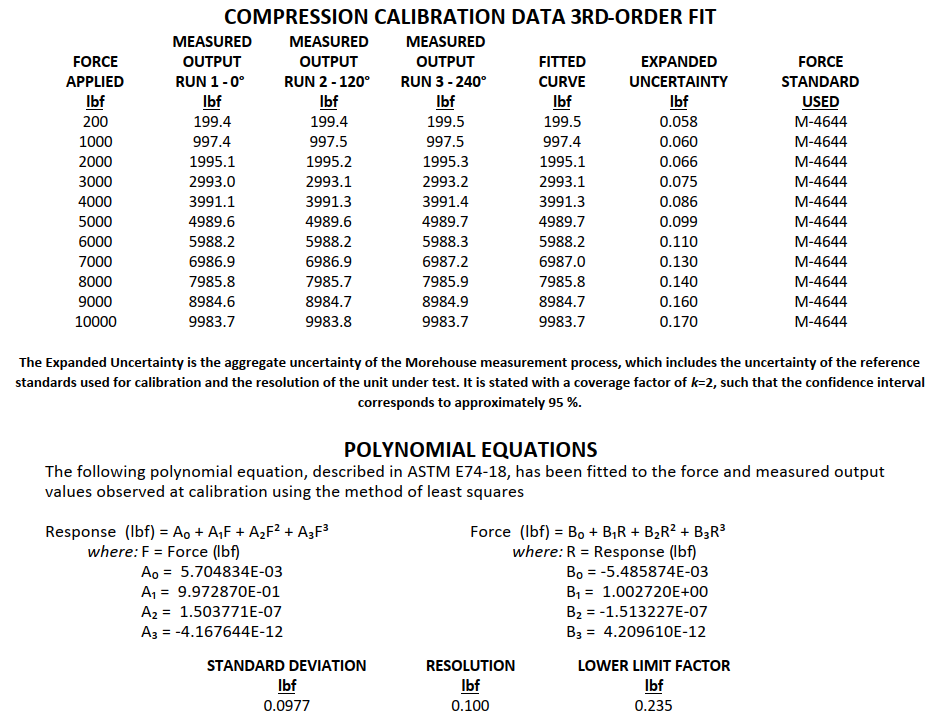Understanding Compression Load Cell Equations
Compression load cells are critical for measuring pushing forces in various applications.
Here at Morehouse, we calibrate many tension load cells from various capacities.
One of the more essential aspects of these calibrations is ensuring the appropriate adapters are used.
Our e-book and other documents speak to the importance of adapters.
After we have all agreed on the proper method for calibration and the adapters used for calibration, it's essential to understand the equations used to characterize their behavior.
This is a basic understanding of the tension load cell equations and how they are used to translate the load cell output into precise force measurements.

Compression Force and Compression Forces Calibration Examples
The Basics of Load Cell Output
A compression load cell at its core converts mechanical force into an electrical signal.
As the load cell is compressed, strain gauges inside the device experience a change in resistance.
This change is typically measured as a voltage output, often expressed in millivolts per volt (mV/V).
Compression Load Cell Equation - Linear Approximation
The simplest way to relate a load cell's output to the applied force is through a linear equation:
Force = m * Response + b
Where:
- Force is the applied tension in units like lbf or N
- Response is the load cell output in mV/V
- m is the slope (sensitivity)
- b is the y-intercept (often close to zero for well-zeroed systems)
This linear approximation works well for many applications, primarily when the load cell is used within a narrow range or where the device may not need to be better than 0.2 % of the full-scale output of the load cell.
When one wants to maximize the performance of their load cell, these slight nonlinearities will not best characterize the performance, and more complex equations will often be needed for better than 0.2 % of full-scale.
Note: We are presenting this in general terms as some load cells can be very linear where the linear equation can be used.
Compression Load Cell Equation - Polynomial Equations for Increased Accuracy
To account for nonlinearities, calibration labs may report polynomial equations to characterize load cells.
ASTM E74 and ISO 376 standards have specific criteria for generating these polynomial equations.
A common form is:
Response = A₀ + A₁ * Force + A₂ * Force² + A₃ * Force³
Where A₀, A₁, A₂, and A₃ are coefficients determined during calibration.
This equation allows us to predict the load cell's response at any given force within its calibrated range. To solve for force when given a response, we can use the inverse equation:
Force = B₀ + B₁ * Response + B₂ * Response² + B₃ * Response³
The coefficients (B₀, B₁, B₂, B₃) are different from the A coefficients and are calculated to minimize errors when converting from response to force.
The Significance of Coefficients
Each coefficient in these polynomial equations serves a specific purpose:
- A₀ or B₀: Represents the offset or zero point
- A₁ or B₁: Relates to the linear sensitivity of the load cell
- A₂ or B₂: Accounts for quadratic nonlinearity
- A₃ or B₃: Addresses cubic nonlinearity

Figure 1 3rd degree Polynomial Compression Load Cell Equation
Higher-order terms (4th or 5th degree) may be used to characterize high-resolution load cells precisely.
These terms have been discussed in our e-book, and the ISO 376 standard limits the use of a polynomial equation to 3rd order.
Compression Load Cell Equation - Practical Application
When calibration is performed following ASTM E74 or ISO 376, you will receive a calibration certificate with these coefficients when using a calibrated compression load cell.
To determine the force for a given output:
- Measure the load cell's output in mV/V
- Plug this value into the Force equation using the provided B coefficients
- Calculate the result to obtain the applied force
Conversely, if you need to know what output to expect for a target force, use the Response equation with the A coefficients.
Compression Load Cell Equation - Conclusion
In conclusion, understanding compression load cell equations can help you better characterize your load cells, lowering the overall uncertainty of the measurements you make.
This lower measurement uncertainty will improve the accuracy of your measurements.
These compression load cell equations, whether linear or polynomial, play a pivotal role in translating a load cell's electrical output into precise forces.
The linear approximation provides a straightforward method for many applications, while polynomial equations offer increased accuracy by accounting for nonlinearities inherent in load cell behavior.
Calibration labs adhering to calibration standards such as ASTM E74 or ISO 376, which define the use of these equations, will often better characterize the load cell's expected performance, allowing you to have more confidence in the performance of your load cells.
About Morehouse Instrument Company
Companies worldwide rely on Morehouse for accuracy and speed. The company turns around equipment in 7-10 business days so customers can return to work quickly and save money.
The York, PA-based company provides force and torque measurement products and services worldwide.
Morehouse Instrument Company, a trusted and accredited provider of force and torque measurement services for over 100 years, offers measurement uncertainties 10-50 times lower than the competition.
Morehouse helps commercial labs, government labs, and other organizations lower their measurement risk by lowering equipment uncertainties for torque and force measurement. Contact Morehouse at info@mhforce.com .
More Information about Morehouse
We believe in changing how people think about force and torque calibration in everything we do.
This includes setting expectations on load cell reliability and challenging the "just calibrate it" mentality by educating our customers on what matters and what causes significant errors.
We focus on reducing these errors and making our products simple and user-friendly.
This means your instruments will pass calibration more often and produce more precise measurements, giving you the confidence to focus on your business.
Companies around the globe rely on Morehouse for accuracy and speed.
Our measurement uncertainties are 10-50 times lower than the competition.
We turn around your equipment in 7-10 business days so you can return to work quickly, saving you money.
When you choose Morehouse, you're not just paying for a calibration service or a load cell.
You're investing in peace of mind, knowing your equipment is calibrated accurately and on time.
Contact Morehouse at info@mhforce.com to learn more about our calibration services and load cell products.
Email us if you ever want to chat or have questions about a blog.
We love talking about this stuff.
Our YouTube channel has videos on various force and torque calibration topics here.
# Compression Load Cell Equation


